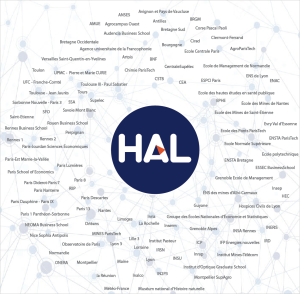Last May representatives of various national and regional open archive networks signed an agreement to enhance their cooperation, the purpose being to come up with an improved working relationship between these networks. Displayed by COAR (Confederation of Open Access Repositories), the text outlines common principles and areas of collaboration with the specific aim of defining standards, API and common protocols to underpin a vast range of network services.
A network of institutional archives
At the national level France is already engaged with HAL on the path towards a network of institutional archives. Today 115 institutions – universities and groups thereof, large schools and research bodies – manage and promote their researchers’ scientific production through a HAL portal*.
A portal is a website with a lasting URL and deposit interface with access to the whole range of HAL services. When managing its archive in HAL, an institution is selecting much more than a material and software infrastructure: it is participating in the management of a vast shared reservoir of data.
- Publications: the affiliations of the authors filled at each deposit ensure automatic supply to the portals. Thus institutions that are joint wards of a single laboratory share the publications produced by all members of this laboratory. What about publications with various authors affiliated in different laboratories? The same principle applies to each of the repositories with a portal: the same deposit is displayed and promoted on each of them.
- The listings: the managers of institutional archives particularly focus on listings for the research structures and the authors and use the AURéHAL platform to manage them. The listing of structures facilitate appropriately the management of the links between teams, laboratories and their institutions. Correct input into the portals and collections depends on good administration of these data. The listing of authors itself notably facilitates making the link with the data added by the author when creating his identifier idHAL (for example ORCID identifiers and idRef or URL of his blog). The listings of ANR** and European projects also enable institutions to extract publications emanating from research financed by funds of the national agency or the European Union.
The network also profits from the pooling of tools developed by HAL users, for importing publications, improving collection management, exporting lists, etc. The most popular tool is Bib2HAL, which was developed by INRIA and made available to all: this application facilitates importation of a group of publications in HAL using the file BibTeX. Another example is OverHAL, developed at the University of Rennes-1, which facilitates comparing HAL and publication lists (WoS, Scopus, Zotero, Pubmed, etc.). The list of these tools and services can be accessed on the special wiki page supplemented by the community of users.
In 2016 the community of those in charge of portals and other users got together to form a club of users called CasuHAL. Its members gather in working groups, exchange information on their practices and are the interlocutors CCSD relies on. Therefore it consolidates the institutional archive network.
Linked to TEL, MediHAL and HAL-SHS
This network is itself connected to other HAL archives, which are also portals but are built on criteria other than institutional:
- TEL for distributing theses. TEL is registered in the circuit defined for the repository and the diffusion of theses at the national level, and is extensively fed by STAR, the service developped by ABES.
- MediHAL for archiving and distribution of images and videos
- HAL-SHS, an open archive dedicated to human and social sciences.
As a common and shared platform HAL creates and reinforces the synergy between these various types of archives.
Visible in OpenAIRE
OpenAIRE (Open Access Infrastructure for Research in Europe) features among the signatories to the international agreement: the role of this European infrastructure is to distribute in open access scientific publications and data on research financed with European funds. One of the ways implemented is to aggregate the data by leveraging reservoirs of data such as HAL, actually registering it in a huge network of data providers.
Connected to large thematic archives
Even vaster are the HAL interconnections with the large disciplinary repositories, namely arXiv, Pubmed, Pubmed Central and RePec, profiting for its entire ecosystem.
- Since its creation HAL has been interconnected with arXiv, open archive of reference in the areas of physics, mathematics and IT. A researcher in one of these disciplines can, when he submits a publication in HAL, request a transfer to arXiv, thereby relieving him of carrying out the same operation on this database.
- In the life sciences this is the PubMed, PubMed Central and Europe Pubmed Central bases, with which HAL interacts: for PubMed Central INSERM pilots the importation of xml files containing the integral article text. In PubMed the deposits of the author versions are notified, thus enabling anybody searching this database to access the same article even if they are not subscribed to the review.
- In economics RePec is a reference resource: HAL transfers the metadata from the repositories of the disciplines concerned so they can also be consulted from this database.
Use of common protocols and standards (OAI-PMH, SWORD, Dublin Core) facilitates these interconnections: they favour the visibility of publications deposited in HAL in these large databases, facilitating their circulation to the scientific communities. HAL’s national scope bestows upon it the role of indisputable interlocutor and facilitates registration of all portals, whether institutional, specific or thematic, in a vast network of interacting data reservoirs.
* A portal is a HAL subassembly: it only displays repositories corresponding to the criteria defining it (e.g. all the repositories for the authors in one establishment). It possesses a website the institution personalises and a repository interface, and is managed internally by one or more administrators.
** ANR : Agence Nationale pour la Recherche. ANR funds project-based research in all science fields (both basic and applied research) through an internationally compliant competitive peer review process; grant recipients include public research organisations, universities, and companies big and small.
